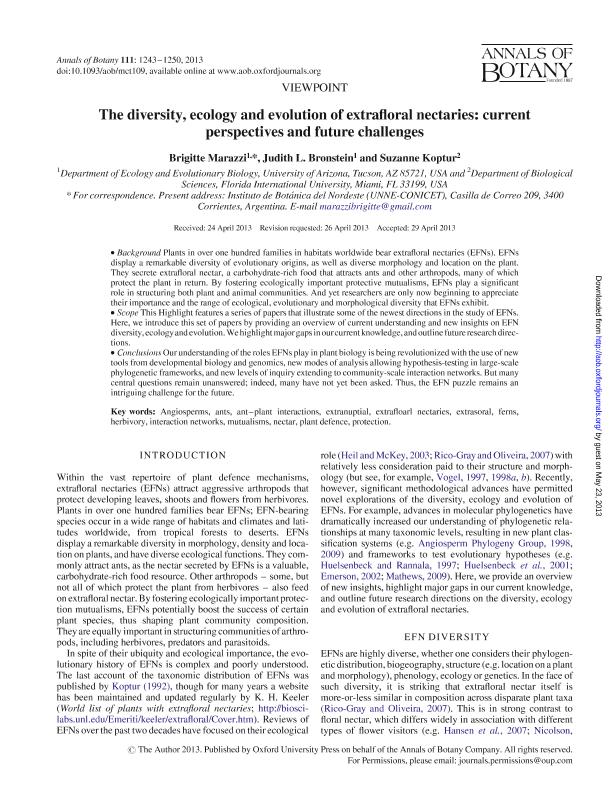Mostrar el registro sencillo del ítem
dc.contributor.author
Marazzi, Brigitte

dc.contributor.author
Bronstein, Judith L.
dc.contributor.author
Koptur, Suzanne
dc.date.available
2016-02-11T13:05:32Z
dc.date.issued
2013-06
dc.identifier.citation
Marazzi, Brigitte; Bronstein, Judith L.; Koptur, Suzanne; The diversity, ecology and evolution of extrafloral nectaries: Current perspectives and future challenges; Oxford University Press; Annals of Botany; 111; 6; 6-2013; 1243-1250
dc.identifier.issn
0305-7364
dc.identifier.uri
http://hdl.handle.net/11336/4124
dc.description.abstract
Background - Plants in over one hundred families in habitats worldwide bear extrafloral nectaries (EFNs). EFNs display a remarkable diversity of evolutionary origins, as well as diverse morphology and location on the plant. They secrete extrafloral nectar, a carbohydrate-rich food that attracts ants and other arthropods, many of which protect the plant in return. By fostering ecologically important protective mutualisms, EFNs play a significant role in structuring both plant and animal communities. And yet researchers are only now beginning to appreciate their importance and the range of ecological, evolutionary and morphological diversity that EFNs exhibit. Scope - This Highlight features a series of papers that illustrate some of the newest directions in the study of EFNs. Here, we introduce this set of papers by providing an overview of current understanding and new insights on EFN diversity, ecology and evolution. We highlight major gaps in our current knowledge, and outline future research directions. Conclusions - Our understanding of the roles EFNs play in plant biology is being revolutionized with the use of new tools from developmental biology and genomics, new modes of analysis allowing hypothesis-testing in large-scale phylogenetic frameworks, and new levels of inquiry extending to community-scale interaction networks. But many central questions remain unanswered; indeed, many have not yet been asked. Thus, the EFN puzzle remains an intriguing challenge for the future.
dc.format
application/pdf
dc.language.iso
eng
dc.publisher
Oxford University Press

dc.rights
info:eu-repo/semantics/openAccess
dc.rights.uri
https://creativecommons.org/licenses/by-nc-sa/2.5/ar/
dc.subject
Angiosperms
dc.subject
Ants
dc.subject
Ant–Plant Interactions
dc.subject
Extranuptial
dc.subject
Extrafloarl Nectaries
dc.subject
Extrasoral
dc.subject
Ferns
dc.subject
Herbivory
dc.subject
Interaction Networks
dc.subject
Mutualisms
dc.subject
Nectar
dc.subject
Plant Defence
dc.subject
Protection
dc.subject.classification
Ciencias de las Plantas, Botánica

dc.subject.classification
Ciencias Biológicas

dc.subject.classification
CIENCIAS NATURALES Y EXACTAS

dc.title
The diversity, ecology and evolution of extrafloral nectaries: Current perspectives and future challenges
dc.type
info:eu-repo/semantics/article
dc.type
info:ar-repo/semantics/artículo
dc.type
info:eu-repo/semantics/publishedVersion
dc.date.updated
2016-03-30 10:35:44.97925-03
dc.journal.volume
111
dc.journal.number
6
dc.journal.pagination
1243-1250
dc.journal.pais
Reino Unido

dc.journal.ciudad
Oxford
dc.description.fil
Fil: Marazzi, Brigitte. Consejo Nacional de Investigaciones Científicas y Técnicas. Centro Científico Tecnológico Nordeste. Instituto de Botánica del Nordeste (i); Argentina. University of Arizona. Department of Ecology and Evolutionary Biology; Estados Unidos
dc.description.fil
Fil: Bronstein, Judith L.. University of Arizona. Department of Ecology and Evolutionary Biology; Estados Unidos
dc.description.fil
Fil: Koptur, Suzanne. Florida International University. Department of Biological Sciences; Estados Unidos
dc.journal.title
Annals of Botany

dc.relation.alternativeid
info:eu-repo/semantics/altIdentifier/url/http://aob.oxfordjournals.org/content/111/6/1243.abstract
dc.relation.alternativeid
info:eu-repo/semantics/altIdentifier/issn/0305-7364
dc.relation.alternativeid
info:eu-repo/semantics/altIdentifier/url/http://dx.doi.org/10.1093/aob/mct109
Archivos asociados
